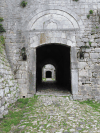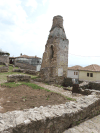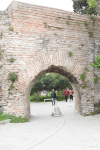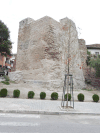
The net protects a fish pond from herons and egrets. (1329k)
My visit to Albania was short, just two days. I did't get to meet local people, I concentrated on historical sites and nature. On this page are a few pictures from everyday life and from historical sites.
All pictures are © Dr. Günther Eichhorn, unless otherwise noted.






From the Rozafa Castle entry in Wikipedia:
Rozafa Castle, also known as the Shkodër Castle, is a castle near the city of Shkodër, in northwestern Albania. It rises imposingly on a rocky hill, 130 m (430 ft) above sea level, surrounded by the Buna and Drin rivers.
Due to its strategic location, the hill has been settled since antiquity. It was an Illyrian stronghold during the rule of the Labeates and Ardiaei, whose capital was Scodra.
During the Third Illyrian War the Illyrian king Gentius concentrated his forces in Scodra. When he was attacked by the Roman army led by L. Anicius Gallus, Gentius fled into the city and was trapped there hoping that his brother Caravantius would come at any moment with a large relieving army, but it didn't happen. After his defeat, Gentius sent two prominent tribal leaders, Teuticus and Bellus, as envoys to negotiate with the Roman commander. On the third day of the truce, Gentius surrendered to the Romans, was placed in custody and sent to Rome. The Roman army marched north of Scutari Lake where, at Meteon, they captured Gentius' wife queen Etuta, his brother Caravantius, his sons Scerdilaidas and Pleuratus along with leading Illyrians.
The 19th-century German author and explorer Johann Georg von Hahn suggested that the ancient and medieval city of Shkodër was located immediately south of the Rozafa hill, between the hill and the confluence of Buna and Drin. The fortifications, as they have been preserved to date, are mostly of Venetian origin.
Within the Castle there are the ruins of a 13th-century Venetian Catholic church, considered by scholars as the St. Stephen's Cathedral, which after the siege of Shkodër in the 15th century, when the Ottoman Empire captured the city, was transformed into the Fatih Sultan Mehmet Mosque.
The castle has been the site of several famous sieges, including the siege of Shkodër of 1478-79 and the siege of Shkodër of 1912-13. The castle and its surroundings form an Archaeological Park of Albania.











The Krujë castle is a castle in the city of Krujë, Albania and the center of Skanderbeg's rebellion against the Ottoman Empire. Inside the castle is the Teqe of Dollme of the Bektashi (an Islamic Sufi sect), the National Skanderbeg Museum, the remains of the Fatih Sultan Mehmed mosque and its minaret, an ethnographic museum and a Turkish bath.
During the Albanian Revolt of 1432-1436 the city was unsuccessfully besieged by Andrea Thopia and Ottoman rule was restored. After Skanderbeg's rebellion in 1443 the castle withstood three massive sieges from the Turks respectively in 1450, 1466 and 1467 with garrisons usually no larger than 2,000-3,000 men under Skanderbeg's command. Mehmed II "The Conqueror" himself could not break the castle's small defenses until 1478, 10 years after the death of Skanderbeg.



From the Durrës entry in Wikipedia:
Durrës is the second most populous city of the Republic of Albania and seat of Durrës County and Durrës Municipality. It is located on a flat plain along the Albanian Adriatic Sea Coast between the mouths of the Erzen and Ishëm at the southeastern corner of the Adriatic Sea. Durrës' climate is profoundly influenced by a seasonal Mediterranean climate.
Durrës was founded by Ancient Greek colonists from Corinth and Corcyra under the name of Epidamnos around the 7th century BCE in cooperation with the local Illyrian Taulantii. Also known as Dyrrachium, Durrës essentially developed as it became an integral part of the Roman Empire and its successor the Byzantine Empire. The Via Egnatia, the continuation of the Via Appia, started in the city and led across the interior of the Balkan Peninsula to Constantinople in the east.
In the Middle Ages, Durrës was contested between Bulgarian, Venetian and Ottoman dominions. The Ottomans ultimately prevailed, ruling the city for more than 400 years from 1501 until 1912. Following the Albanian Declaration of Independence, the city served as the capital of the Principality of Albania for a short period of time. Subsequently, it was annexed by the Kingdom of Italy in the interwar period and was occupied by Nazi Germany during World War II. Durrës experienced a strong expansion in its demography and economic activity during the Communism in Albania.
Though surviving remains are minimal, Durrës is one of the oldest cities in Albania. In terms of mythology, the genealogy of the foundation of Dyrrhachium includes among the founders Illyrian men (the Illyrian king Epidamnos and his grandson Dyrrachos), Greek men (the Corinthian Falio, descendant of Heracles), heroes (Heracles who was given part of the lands) and gods (Poseidon, as father of Dyrrachos).














This page contains 34 pictures

Main page for Shqipëri (Albania)
Page last updated on Sat Jun 4 17:33:25 2022 (Mountain Standard Time)
People in Albania on gei.geichhorn.com